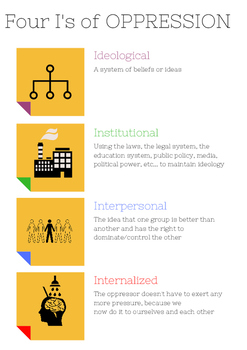The Four I's Of Oppression- Training Recourses for the Environmental Community
The article The Four Is of Oppression explains how oppression continues in society through four main ways: ideological, internalized, interpersonal, and institutional oppression.
IDEOLOGICAL-
Ideological oppression comes from belief systems that justify discrimination and unfair treatment, often making it seem like certain injustices are just “common sense.” These ideas can lead people to dehumanize others and even justify violence. To challenge ideological oppression, individuals and communities need to push for long-term changes in culture, politics, and education. This can include things like learning about historical injustices, supporting anti-oppression movements, and questioning harmful societal norms.
INTERNALIZED-
Internalized oppression happens when people take in harmful beliefs and start applying them to themselves or others. This can make marginalized people feel like they have to work extra hard to be valued or can make them doubt their own abilities. On the other hand, it can cause people from dominant groups to feel entitled or assume negative things about others. The best way to address internalized oppression is through education that focuses on accurate history and anti-oppression values. Programs like anti-racism workshops, discussions in safe spaces, and learning about different perspectives can help people become more aware of the biases they’ve absorbed and work toward changing them.
INTERPERSONAL-
Interpersonal oppression is when these harmful beliefs show up in everyday interactions between people. This can range from microaggressions to outright acts of discrimination or violence. Because interpersonal oppression is so visible, it has an immediate effect on people, making them feel unsafe or disrespected. When it’s unintentional, it can be addressed by raising awareness and holding people accountable for their actions. However, when it’s intentional or violent, the priority should be protecting the victims and taking action against the aggressors.
INSTITUTIONAL-
Institutional oppression happens at a larger scale through laws, policies, and practices that keep inequality in place. Examples include biased hiring processes, strict standardized testing requirements that disadvantage marginalized students, and racial profiling in law enforcement. Because these issues are built into systems, fixing them requires big changes, like reviewing policies, making sure there’s real accountability, and ensuring that institutions commit to diversity, equity, and inclusion. Organizations and governments need to invest in making these changes by listening to affected communities and creating fairer policies.
Overall, fighting oppression requires both individual and collective action. People need to recognize how oppression works and take responsibility for challenging it. This means being open to feedback, learning about different experiences, and pushing for changes in policies and practices. By making an effort to be more aware and take action, individuals can contribute to larger movements for justice and equality.


Nice blog post Ry! Very thorough with your explanations and I like your image.
ReplyDeleteYour dissection of the internalized piece of the puzzle was very eye-opening; A main issue with life holds its roots in many of our everyday functions. To think that the solution to one of our country's major issues lies within our daily behaviors and everyday places. I like the simplicity of your proposed solutions, boiling down to just discussing regularly with people in safe spaces. Having that sort of sanctuary is a great tool for anyone's life.
ReplyDeleteHey Ry, it is terrible that some individuals believe it is appropriate to walk all over others, and there is a great deal of discord toward people in this world. Instead of encouraging one another, individuals start treating others unfairly because of their sexual orientation, race, lifestyle and culture, and religions.
ReplyDeleteI liked your explanation of internalized. It was eye opening about how common it is. I liked how you proposed solutions as well.
ReplyDelete